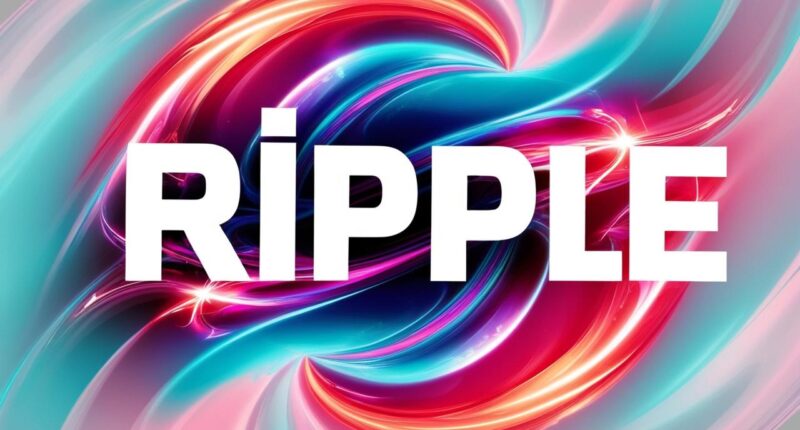Ripple is a key player in the cryptocurrency industry, recognized for its advanced technology and payment solutions. It operates primarily through the XRP Ledger (XRPL), which allows for quick transactions, settling in 3 to 5 seconds and processing up to 1,500 transactions per second. XRP, the native digital asset, is used as a bridge currency, supporting cross-border transactions. Ripple also provides solutions for financial institutions, reducing the need for pre-funded accounts. More insights follow on its regulatory challenges and future plans.
Ripple has emerged as a significant player in the cryptocurrency landscape, primarily through its innovative technology and payment solutions. Central to Ripple‘s offerings is the XRP Ledger (XRPL), a decentralized public blockchain that utilizes a consensus algorithm instead of traditional mining. This allows transactions to settle in just three to five seconds, processing up to 1,500 transactions per second while maintaining low energy consumption when compared to Bitcoin. Ripple is also the first financial services platform using blockchain and cryptocurrency for enterprises, showcasing its pioneering role in the industry. Additionally, Ripple aims to streamline the cross-border payment process by eliminating multiple transaction layers, enhancing the efficiency of international transactions. Moreover, Ripple’s solutions are increasingly being recognized for their potential to integrate with XRP-backed securities, which could further enhance liquidity in financial markets.
Ripple stands out in cryptocurrency with its XRP Ledger, enabling swift, energy-efficient transactions through innovative consensus technology.
The native digital asset of the XRP Ledger is XRP, which was pre-mined with a total supply of 100 billion tokens at its inception. XRP serves multiple purposes, including facilitating transactions and acting as a bridge currency for various financial operations. Transaction fees are minimal, costing only 0.00001 XRP per transaction, and importantly, XRP is not directly controlled by the Ripple company, enhancing its independence.
RippleNet is the payment network developed by Ripple, designed specifically for financial institutions. It enables seamless cross-border transactions and employs XRP for on-demand liquidity, effectively reducing the reliance on pre-funded nostro accounts. Ripple has established partnerships with major banks and remittance providers, further solidifying its position in the global payment ecosystem.
Founded in 2012, Ripple originally operated as OpenCoin before rebranding. The company focuses on creating enterprise blockchain solutions, although it has faced challenges, including a lawsuit from the SEC regarding the classification of XRP as an unregistered security. A 2023 court ruling clarified that XRP itself is not a security, allowing for its relisting on exchanges and indicating a potential pathway for Ripple amid ongoing regulatory scrutiny.
Ripple’s future prospects include exploring central bank digital currency (CBDC) solutions and developing smart contract functionality on the XRPL. The company is also looking to expand into decentralized finance (DeFi) applications and aims to tokenize real-world assets while pursuing a goal of becoming carbon-neutral by 2030. This forward-thinking approach demonstrates Ripple’s commitment to innovation in the evolving landscape of cryptocurrency.
Frequently Asked Questions
Is Ripple the Same as XRP?
Ripple and XRP are not the same entity.
Ripple is a technology company that develops blockchain solutions for financial institutions, while XRP is a digital asset created by Ripple.
Although Ripple uses XRP in some of its products, XRP can function independently on the XRP Ledger, a decentralized network.
Ripple does not control XRP, and the two serve distinct purposes in the financial ecosystem, highlighting their separate identities and functionalities.
Can Ripple Be Used for Personal Transactions?
Ripple can indeed be used for personal transactions. Individuals can send XRP directly to one another, enabling quick transfers that settle within 3-5 seconds.
The transaction fees are very low, typically around 0.00001 XRP, making it suitable for remittances and micropayments.
To initiate a transaction, one must create a compatible wallet, purchase XRP from an exchange, and obtain the recipient’s XRP address.
Monitoring transactions can be done through the XRP Ledger explorer.
How Does Ripple Differ From Bitcoin?
Ripple and Bitcoin differ considerably in their transaction speed and consensus mechanisms.
Ripple processes transactions in 3-5 seconds and can handle 1,500 transactions per second, while Bitcoin takes about 10 minutes per transaction and manages only 7 per second.
Additionally, Ripple uses a Federated Byzantine Agreement for validation, making it more energy-efficient compared to Bitcoin’s Proof-of-Work mining.
Ultimately, Ripple targets financial institutions, whereas Bitcoin is more focused on peer-to-peer transactions.
Is Ripple Decentralized or Centralized?
Ripple exhibits both centralized and decentralized characteristics.
Ripple Labs controls a significant portion of XRP supply and influences the development of the XRP Ledger.
However, the XRP Ledger operates on an open-source protocol, allowing anyone to run a validator node, which guarantees that no single entity controls transaction validation.
Consequently, while Ripple Labs has corporate influence, the system enables independent validators to participate, balancing centralized control with decentralized operations.
What Companies Are Currently Using Ripple Technology?
Several companies currently utilize Ripple technology for various financial services. Notable financial institutions include Santander, American Express, and Bank of America.
Payment providers such as MoneyGram and Western Union have also integrated Ripple for international transactions.
In the remittance sector, companies like InstaReM and Cuallix employ RippleNet for efficient cross-border payments.
Additionally, enterprises like CGI and Finastra have adopted Ripple’s payment solutions, enhancing their capabilities in global financial transactions.
References
- https://www.investopedia.com/terms/r/ripple-cryptocurrency.asp
- https://www.blockchain.com/learning-portal/tokens/ripple-explained
- https://www.satoshitango.com/global/currencies/ripple
- https://calebandbrown.com/blog/what-is-xrp/
- https://101blockchains.com/ripple-xrp-in-blockchain-and-finance/
- https://coinpaper.com/5809/what-is-xrp-a-brief-guide-to-ripple
- https://bernardmarr.com/what-is-the-difference-between-bitcoin-and-ripple/
- https://xrpl.org/about
- https://corporatefinanceinstitute.com/resources/cryptocurrency/ripple/
- https://cointelegraph.com/learn/articles/what-is-ripple-a-beginners-guide-for-understanding-ripple









